Affiliate disclosure: This post may contain affiliate links. Please see our Privacy Policy.
Canning meat is one of the simplest and most versatile ways to preserve meat without refrigeration. Learn how to can meat at home including beef, pork, chicken, venison, and more.
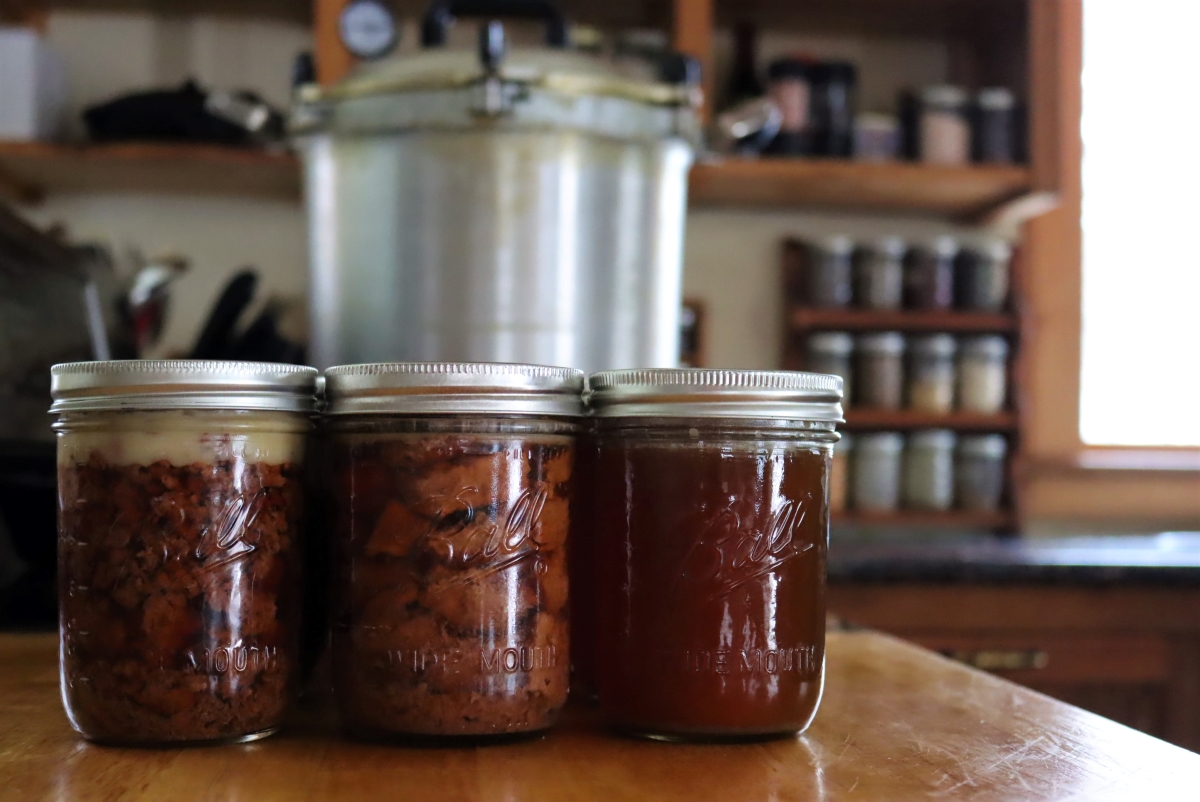
Canning meat at home means that you have shelf-stable, ready-to-eat protein at a moment’s notice.
With home canned meat, you don’t have to worry about power outages destroying a freezer full of meat, and there’s no need to thaw can cook at mealtime. In a pinch, you can even just eat canned meat right out of the jar with a fork (though, of course, it’s better if you heat it first).
Low quality, tough cuts are tender and delicious after pressure canning. It’s like they’ve been slowly braising all day long.
What Meats Can Be Canned?
Most types of meat can be canned at home. This includes domesticated farm-raised meat, as well as wild hunted meat.
This includes beef, veal, pork, lamb, mutton, venison, moose, and bear.
Poultry and small game meat may also be canned, including chicken, turkey, duck, goose and rabbit.
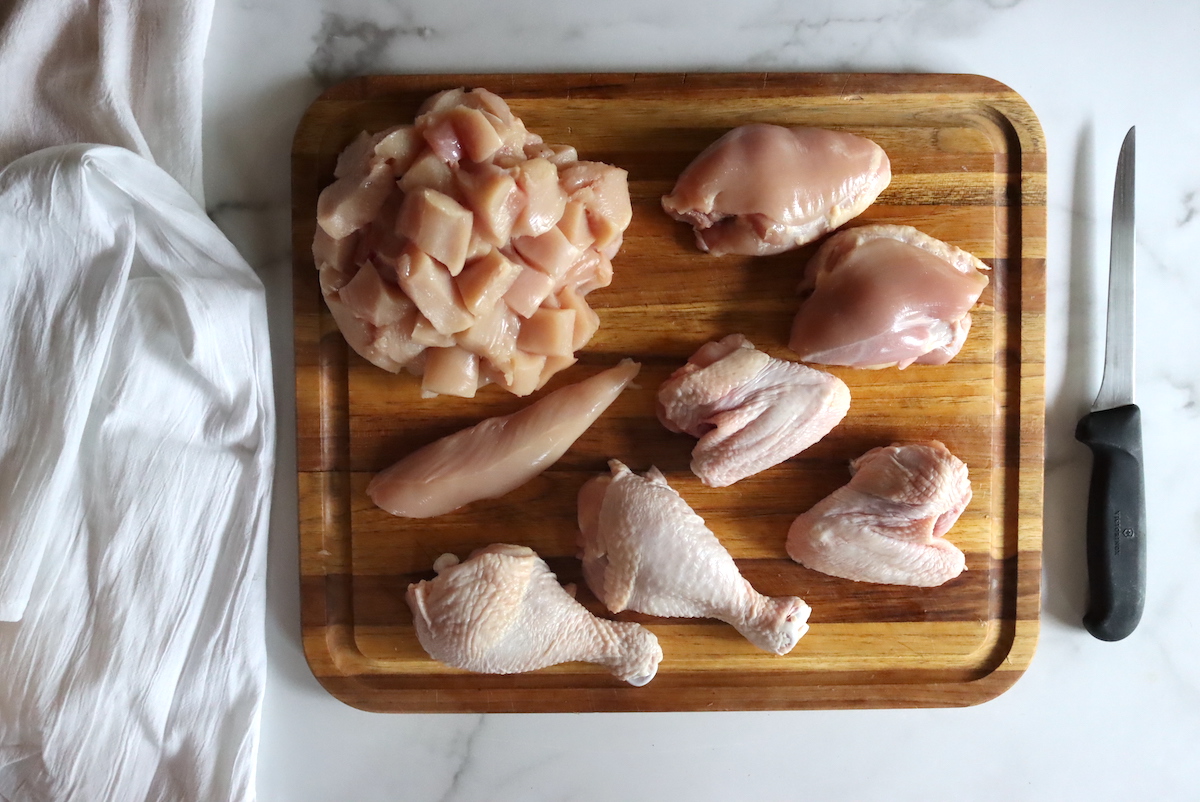
Most (though not all) types of fish and shellfish can also be canned as well, and I’ll cover those in a separate article as they’re a bit more particular when it comes to home canning.
The only safe way to can meat is with a pressure canner, which reaches temperatures over 240 degrees F.
Boiling water bath canners cannot be used to can meat, as they only reach 212 degrees. That’s fine for pickles, jams, and relishes, but water bath canning just doesn’t get hot enough to safely preserve low acid foods like meat.
If you’re not familiar with pressure canning, I’d strongly recommend reading my beginner’s guide to pressure canning before you get started.
Beyond that, be sure that you have a pressure canner (rather than a pressure cooker). Your instant pot will not work for canning, and most electronic countertop pressure cooking appliances don’t work either.
The two most common brands of pressure canner are:
- All American Pressure Canners – Weighted gauge pressure canners that are durable, easy to use, and last a lifetime. No gaskets or seals to replace, and high capacity. This is what I use.
- Presto Pressure Canners – Great for beginners, these are inexpensive and easy to find. They have a dial gauge, which makes them a bit harder to use since you’ll be constantly adjusting the stove to maintain proper pressure. They also have rubber gaskets that need to be replaced regularly.

Canning Meat
People often ask, do you cook meat before canning? Is that really necessary, it’s going to be pressure cooked in the jar for an extended period anyway.
You don’t have to cook meat before canning, and it’s perfectly safe to can raw meat. The canning times and pressures for meat are exactly the same for raw packs and hot packs.
The main difference here is quality. If it’s meat you would brown before stewing, then I’d strongly suggest browning it before canning it.
Stew beef chunks, for example, can just be tossed into the pot along with potatoes and carrots for beef stew. The stew tastes much better, however, if you brown the beef before adding it to the stew, even though it’s going to slowly cook all day long in the pot.
I recommend browning beef, lamb, venison, and pork in all cases. Poultry, however, is often simply poached without browning and the results are lovely. I’ll discuss poultry separately, but in general, I would suggest canning poultry as a raw pack and browning (hot packing) all other types of meat.
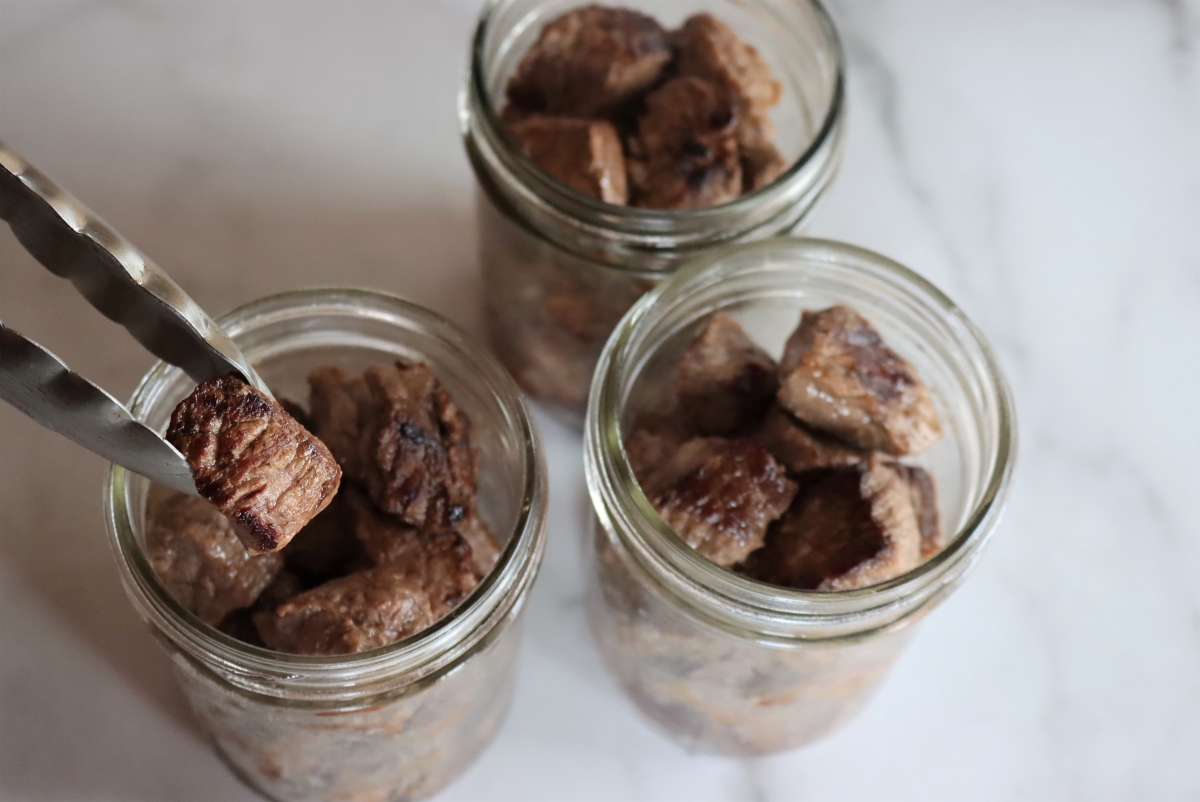
Canning Red Meat (Beef, Lamb, Pork, Venison, etc)
This includes Bear, Beef, Lamb, Pork, Veal, Venison, Moose, and Goat Meat (Chevon).
The basic instructions for canning meat are to prepare the meat by trimming off as much fat as possible and then browning it in a bit of oil. The meat can be large chunks (roasts), small stew chunks, steaks, strips, loose pack ground meat crumbles, or formed patties.
As I’ve mentioned, browsing is optional, but the end result is much better.
Bone-in chunks are allowed, though bones do take up a lot of space in the jars. This is usually only done for beef short ribs, and other cuts are boned before canning. Canning times and pressures are the same for boned and bone-in cuts. (For poultry, bone-in cuts have different canning times, which I’ll discuss separately).
For Hot Pack, the hot, freshly browned meat is packed into jars leaving 1-inch headspace. It’s then topped with boiling water or meat stock before canning. (Still maintaining a 1” headspace.)
For Raw Pack, the meat is simply packed into jars raw with no added liquid. The meat will let out liquid as it cooks and create its own broth. Be sure to leave 1” headspace.
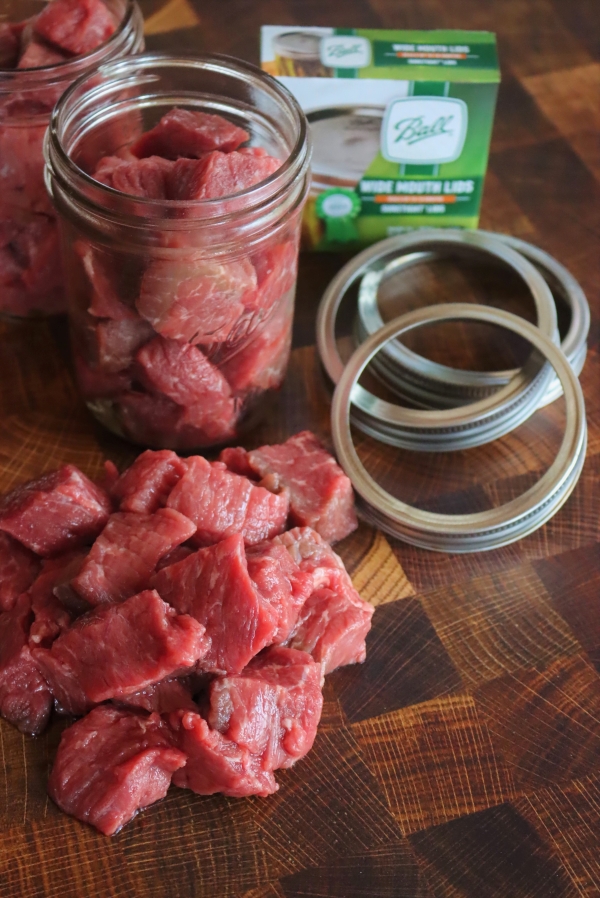
If you’re not familiar with pressure canning, please read my primer on pressure canning or the manual on your specific canner before beginning.
In general, the process is to seal the jars with 2 part canning lids and load them into a pre-warmed pressure canner. Close up the canner, but don’t seal it yet. Allow steam to vent for 10 minutes to ensure that the chamber is fully hot and full of steam, then seal the chamber and bring it up to pressure.
Once the canner is up to pressure, start the timer and maintain pressure until the canning time is complete.
Canning times and pressures for canning meat can be found in the table below. It’s always 75 minutes for pints and 90 minutes for quarts, regardless of the type of meat and altitude. The pressure is adjusted based on your altitude, but the canning time remains the same.
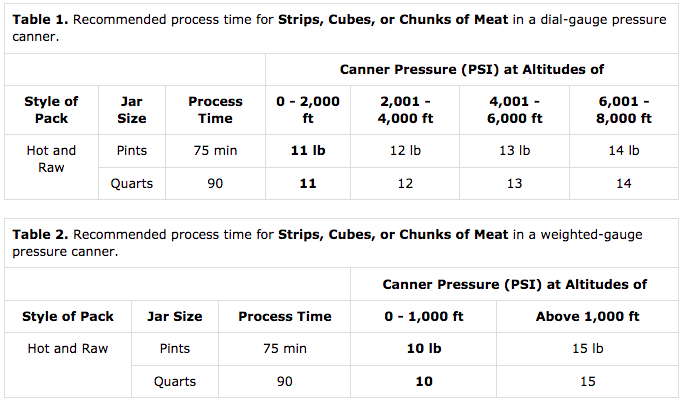
Beyond meat cuts, you can also can sausage and hamburger, either as lose pack crumbles or in patties or links. Be sure that the sausage does not contain any ingredients that are not approved for canning. Namely, it should not have flour, corn starch, grains, thickeners of any kind, butter, or dairy products.
The process for canning strained meat stock or broth is a bit different, and I’ll cover that separately.
Beef Canning Recipes (also Lamb, Mutton & Goat)
While beef is the most popular for canning in the US, you can also use lamb, mutton, and goat in any of these recipes.
Pork, chicken, and other meats are also fine safety-wise in these recipes, but they’ve really been formulated for red meats based on the seasonings.
- Canning Beef
- Canning Ground Beef (or Hamburger)
- Canning Chili con Carne (Meat Chili)
- Canning Pasta Sauce with Meat
- Canning Mincemeat Pie Filling
- Canning Beef Short Ribs
- Canning Beef Stew
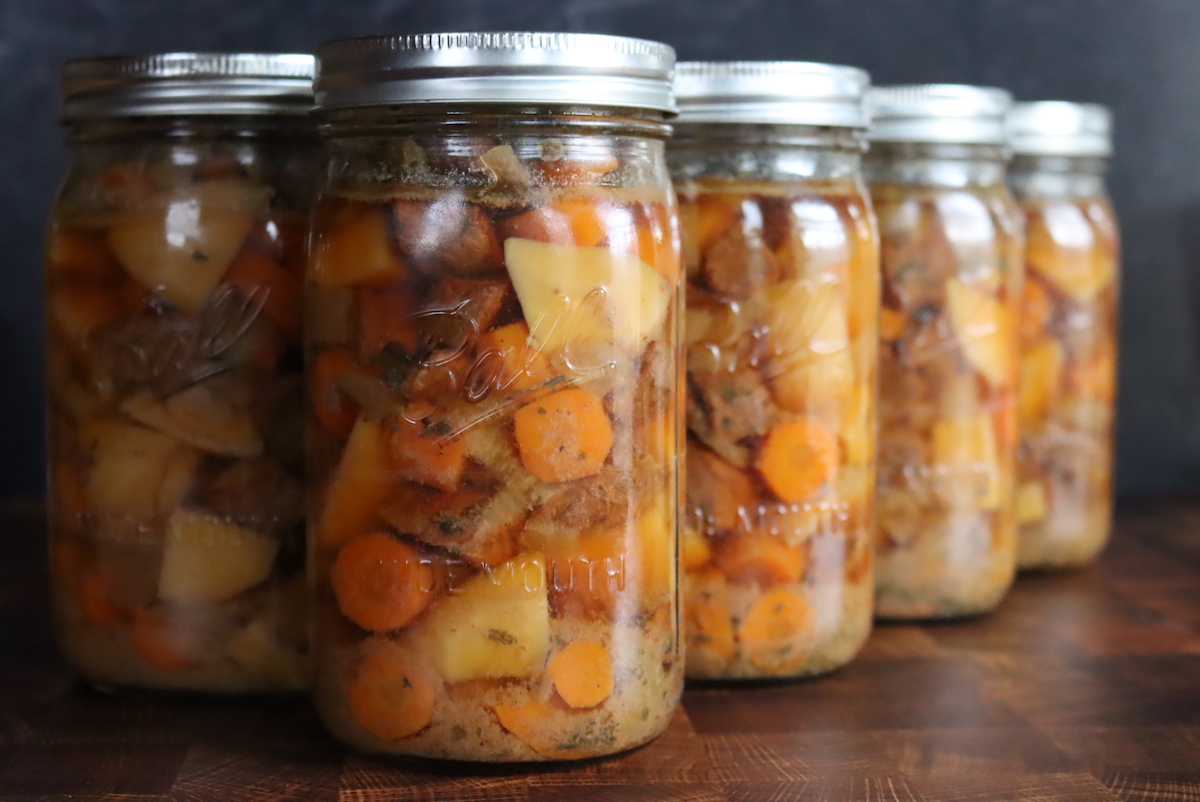
Pork Canning Recipes
Though the canning times and pressure are the same as for beef, pork canning recipes tend to be a bit different because it’s honestly a completely different animal with very different meat.
There’s more fat to deal with, and the seasonings are very different than dealing with beef. Still, safety-wise you can substitute any meat into these recipes.
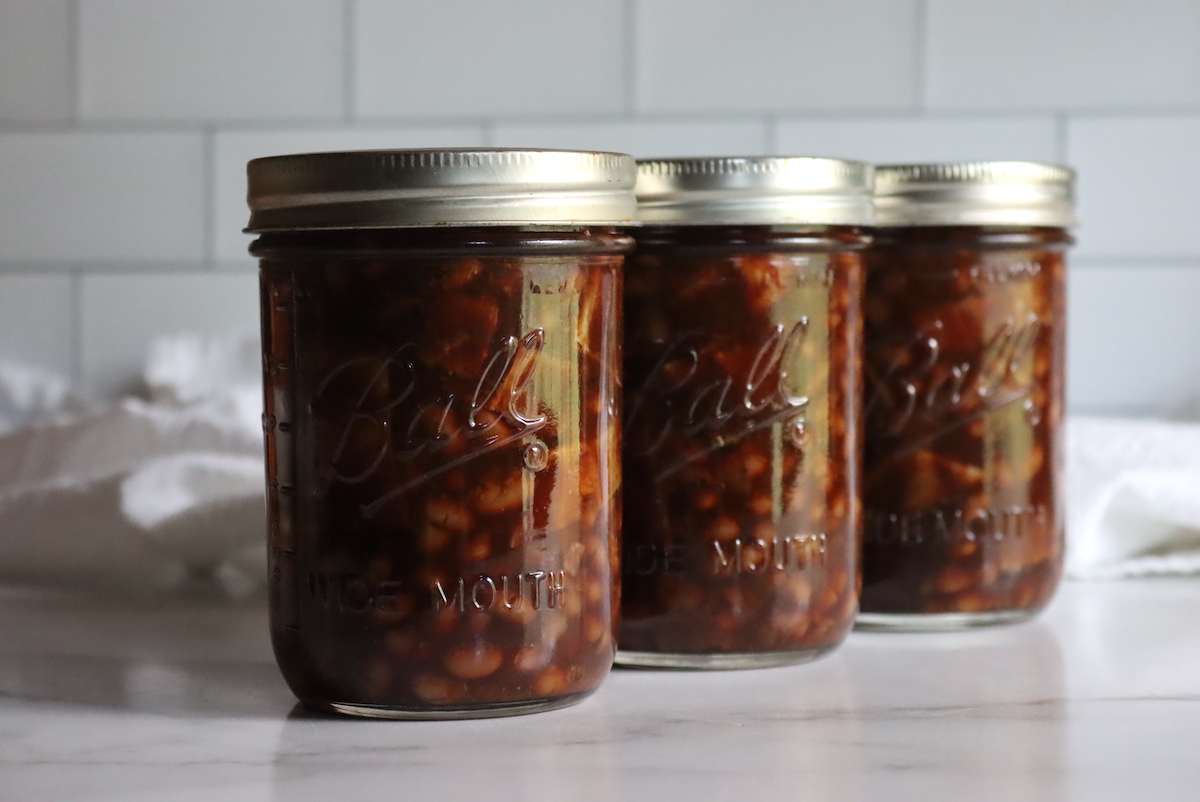
Wild Game Canning Recipes (Venison, Bear, etc)
Though wild game seems like it should be different, it’s actually exactly the same as canning farm-raised meat, at least from a food safety perspective.
The one thing to note is that most canning manuals suggest avoiding canning deer bones and deer stock. That’s because the exact nature of “chronic wasting disease,” an issue carried by some deer, is not known. They know it’s not spread through the meat to humans, but bones and other tissues are unclear.
For that reason, they suggest steering clear of cooking with deer bones. (Many people still choose to pressure can venison stock, but be aware that it’s at your own risk.)
Canning Poultry and Rabbit (Chicken, Turkey, Duck, Goose & Rabbit)
In general, the times, pressures, and instructions for canning poultry and rabbit are the same as canning other meats. It’s still 75 minutes for pints and 90 minutes for quarts, with pressure adjusted for altitude in exactly the same way as for beer and other meats.
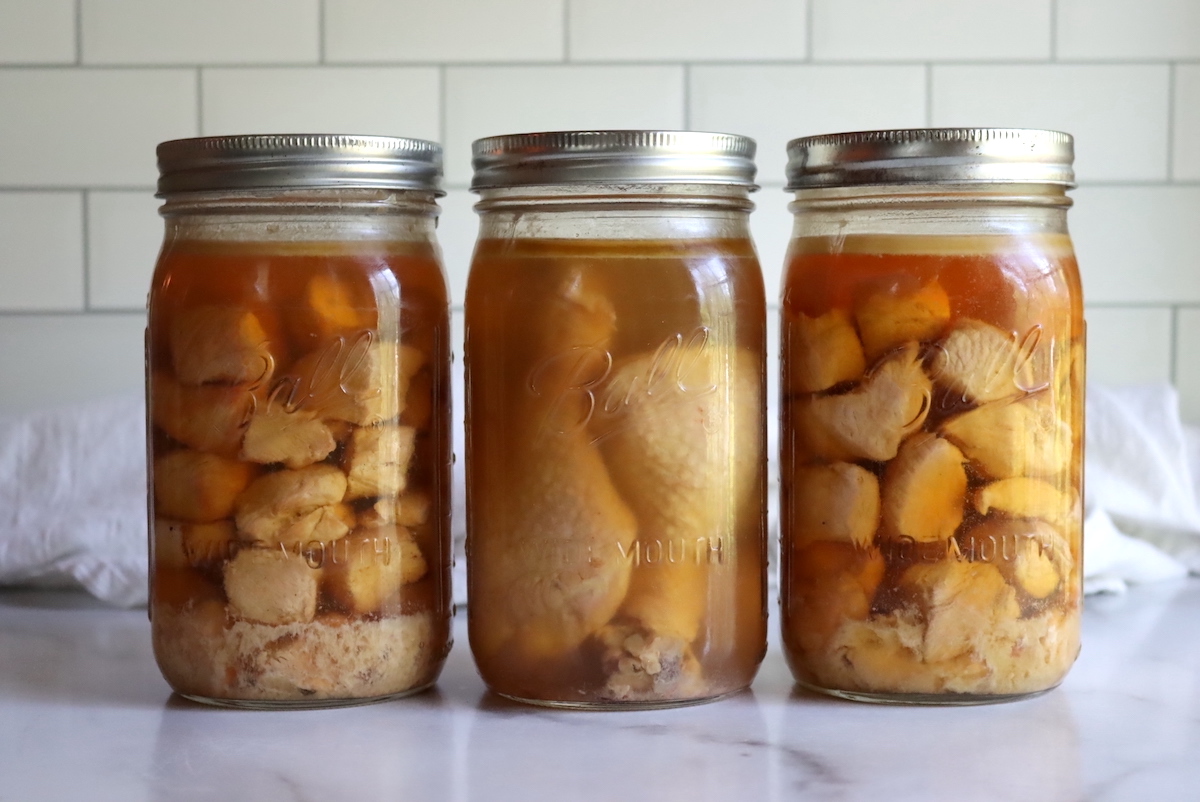
The main difference here is when you can “bone-in” chicken, such as a jar of chicken drumsticks, the canning time is less.
Bones, specifically poultry and rabbit bones, conduct heat better than plain meat and allow for quicker heat penetration into the center of the jar.
When chicken or rabbit is canned bone in the times are reduced to 65 minutes for pints and 75 minutes for quarts. See the table below for altitude-adjusted pressure.

It’s important to note that these reduced “bone-in” canning times only apply to poultry and rabbit.
Other meats are occasionally canned with bones, such as beef short ribs, but you must use the regular “all meat” canning times (75 and 90 minutes) for those.
While beef and pork are sometimes canned as mince or sausage, that’s not usually done with chicken simply because it’s not the best sausage. Still, if you want to can ground chicken crumbles or homemade chicken sausage, that’s fine provided it doesn’t contain any ingredients that cannot be canned (dairy, flour, etc).
While canning ground chicken isn’t really a thing, canning leftover poultry is quite common. Especially canning leftover turkey after thanksgiving.
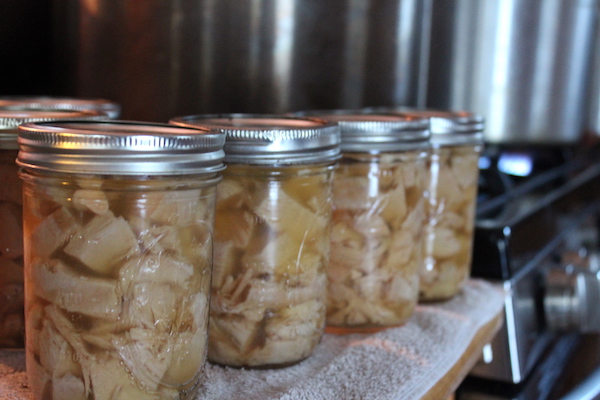
Poultry Canning Recipes
Again, all of these recipes can be used with any type of meat, the seasonings are just formulated specific to chicken and other poultry but you could substitute in other types of meat.
If you do substitute red meat for a “bone-in” chicken canning recipe, be sure that you use the full canning times (75 min for pints and 90 minutes for quarts) instead of the reduced bone in canning times that are given for chicken (65 and 75 minutes).
Pressures are the same, and vary by altitude only, not type of meat.
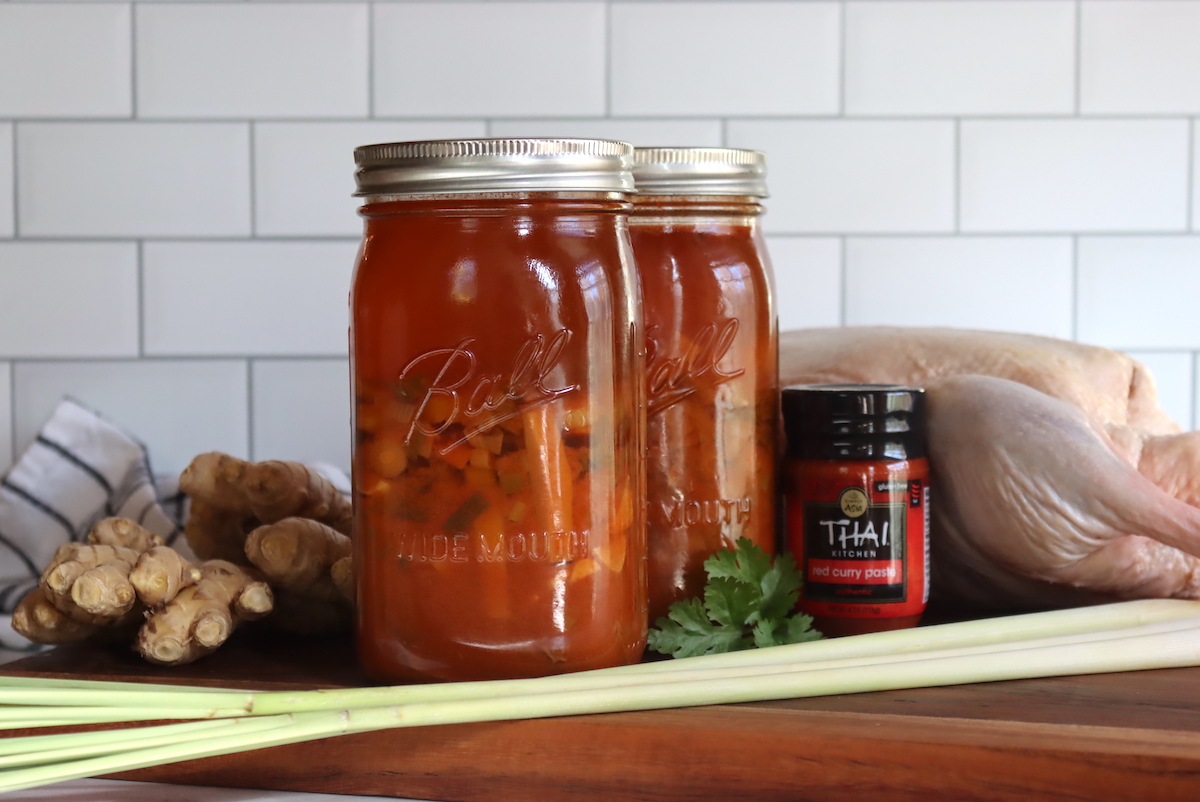
Canning Meat Broth and Stock
Broth and stock are a bit different than canning the meat itself. It’s still a low acid food, of course, and must be pressure canned, but the canning times are much shorter.
The heat from the pressure canner is able to penetrate evenly and quickly throughout broth and stock since there are no solids in the mixture.
That means the total time for canning meat broth is much shorter than canning meat.
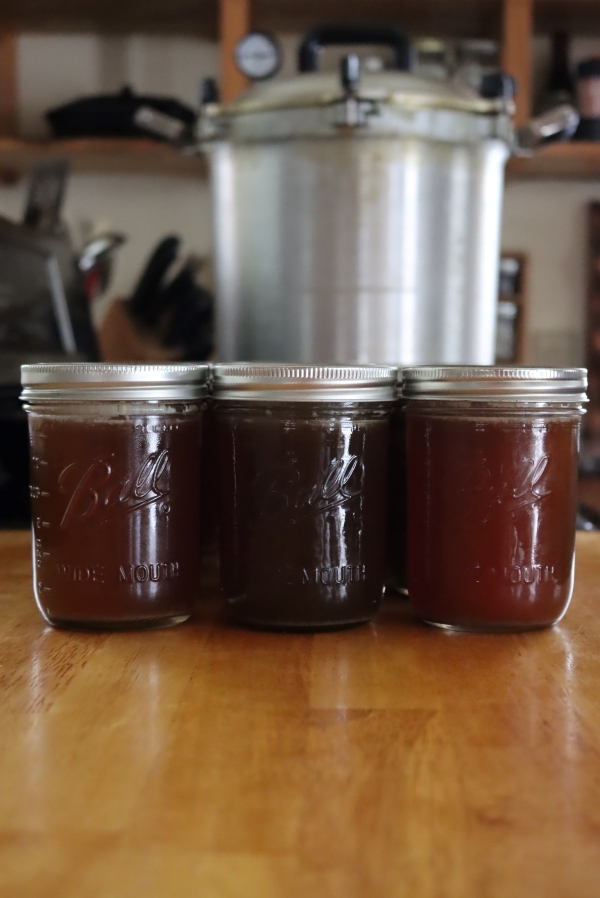
Prepare meat broth or stock as you otherwise would, and be sure to filter out all the solids. We use cheesecloth to get every last bit, which results in a much clearer broth.
Load the boiling broth into pint or quart canning jars, leaving 1” headspace. Seal with 2 part lids and load into a pressure canner.
Process the jars for 20 minutes for pints, 25 minutes for quarts, adjusting pressure for your altitude using the table below:
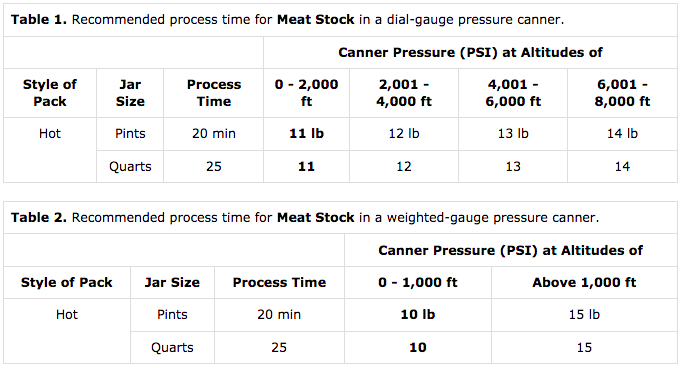
If you’re looking for specific recipes for canning meat stock at home, I have a few to get you started:
I also have a guide to making the best bone broth, so you do the job right.
Canning Fish and Seafood
Once you leave land for creatures of the sea, the canning process gets a bit more complicated. There are very specific instructions for canning tuna, for example, which are much more exacting than canning meat in general.
Even though it’s more complicated, it can be done. There are tested and approved recipes for canning all manner of seafood.
I’ll write up a specific primer on canning fish and seafood soon, but in the meantime, here are some resources for canning fish at home just to get you started.
- Canning Fish (Salmon, Trout, etc…but not tuna)
- Canning Tuna
- Canning Smoked Fish
- Canning Oysters
- Canning Crab
- Canning Clams
Canning Guides
Putting up more than just meat this season? I have plenty of canning guides to keep your pantry full!
- 50+ Vegetable Canning Recipes
- 100+ Canning Recipes (How to Can Everything)
- How to Make Jam (with 30+ Recipes)
- 30+ Tomato Canning Recipes
- 12+ Apple Canning Recipes
- Zucchini Canning Recipes
Pressure Canning Recipes
Looking for more pressure canning recipes?
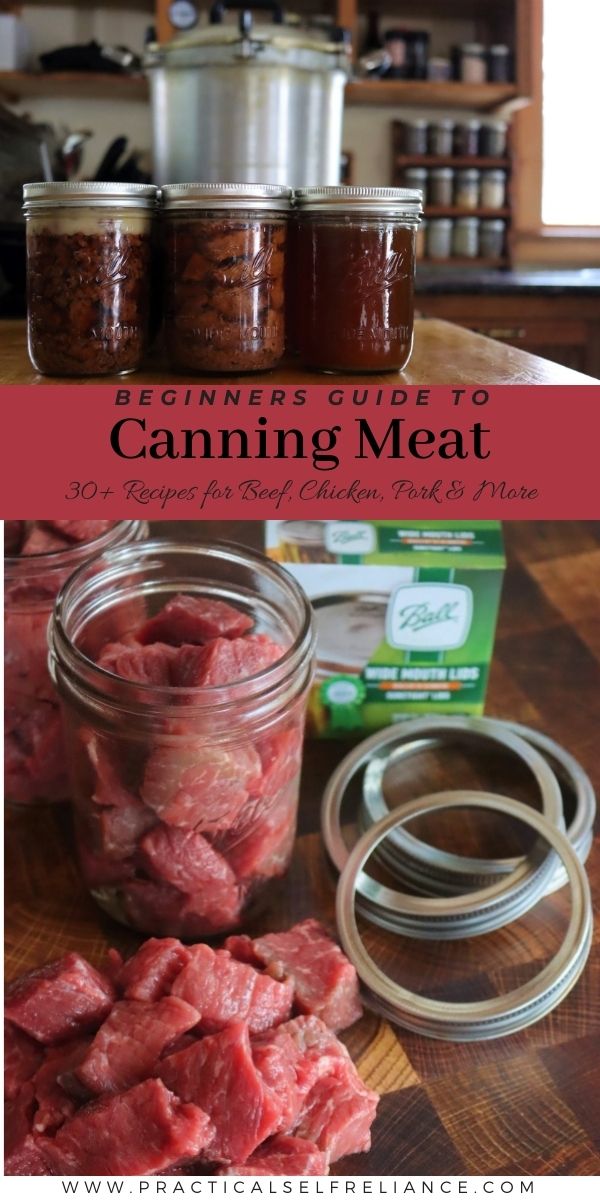
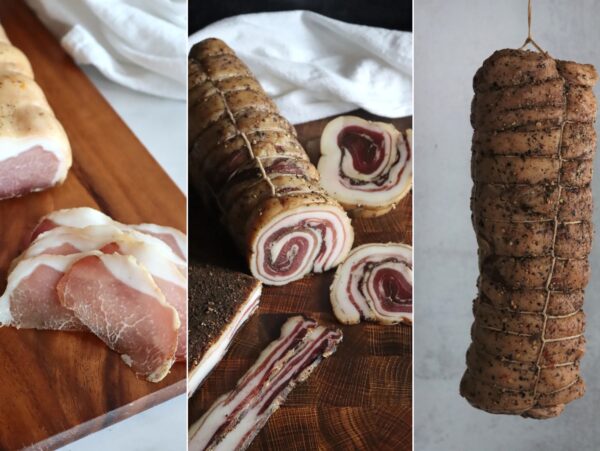


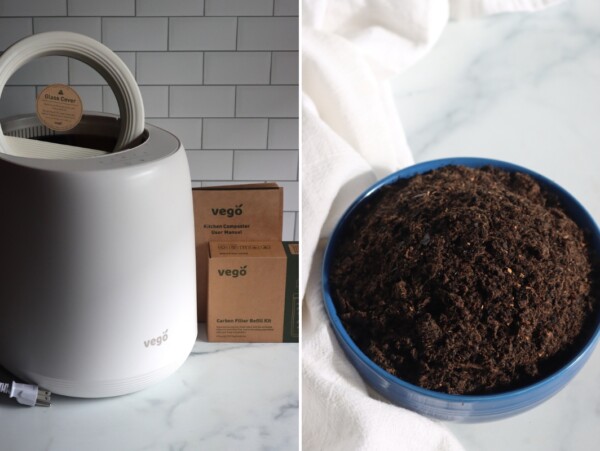
I’m new to canning, i see some recipes call for 11 pounds pressure but the weights at 5 10 and 15. how do you compensate for the extra pound?
If it’s 11 pounds then I would bump it up to 15.
Just curious, do you trim all the fat from beef due to a problem with sealing? I would prefer canning with at least some of the fat for better nutrition. What about canning something like chicken thighs which have fat? Thanks.
Yes, it does interfere with the sealing process of the jars. The other issue is that the fat can also interfere with the heat processing. Fat molecules can actually surround the bacterial spores and protect them from being destroyed. You also run the risk of the fats going rancid.
Hello!!!???
Hi. Did you have a question or comment?
I’m at sea level and only have a 15 psi weight
Do I adjust my cooking times?
Thanks
T.
Does your weight not have 3 separate holes? One should be for 5 psi, one for 10 and one for 15.
how long would you pr0cess chicken in half pint jars?
You can just use the processing time for pints.
Is there a way to print some of these articles? I find them so helpful!
You can print straight from the page but it will print the ads along with the article. You can also copy and paste or check out the Substack subscription for an ad free experience.
What size of pressure canner do you use? I have been told you cannot can meat in a smaller (15.5 Qt) canner because there isn’t enough room for air circulation to get the high temp necessary. Sounded strange to me but as I have never canned meat I want to be sure my family is safe. Thank You
I would just check with the manufacturer of the pressure canner that you are wanting to use. If you look up the 15 quart pressure cooker on the All-American website. It does state that it’s not recommended for smoked fish because of the air circulation issue but it makes no mention of not using it for meat. With that said, you really can’t go wrong with a bigger model. A 30 quart will hold 19 pints or 14 quarts.
I’m wanting to can chicken and andouille sausage together for gumbo. The andouille does not have flour, cornstarch or dairy. Would this be okay? Also the chicken and sausage are cooked so I would cover with the chicken broth. Thank you for your help.
The only issue that you might see is with the seasoning. Sometimes seasonings can have an off flavor when canned.
Hi, It’s my understand that you are not to can in 1 gal jars with raw beef! Being that the temp will not get high enough. I understand that. My question is: If I make a taco soup that cooks in a crock pot all day. And while it’s still hot I water bath it in 1 gal jars. In a pot that will cover 95 % of the jar in water, why is that not ok? Its already cooked meat. It’s still hot and will be heated again for say 15 mins at my altitude. To just bring the temp up to seal the jar? Can someone please explain.
Thanks
All meats and other non acidic vegetables must be pressure canned in order to be shelf stable. The temperatures in a pressure canner reach 240 and a water bath canner only reaches a temperature of 212.
Tyndallization works too – especially if you don’t have pressure canner. You basically sterilize in boiling water bath three times in 24h increments for about 90 minutes each time. Autoclave is better, but let’s not forget tyndallization was used for ages before.
I’m new to canning and love your site. Thanks for all the wonderful advice. A couple of my jars of meat didn’t have water covering the meat all the way to the top of the jar. Will these be ok to can or should I use them up right away? And is it ok to add water to raw pack canned meats? Thank you!
It sounds like you may have had some siphoning happening. There are several reasons why this might happen. We have a section on siphoning in this post about pressure canning. https://practicalselfreliance.com/pressure-canning/ As long as the meat was canned properly and you haven’t lost more than half of the liquid it should be totally safe. You do not want to add any additional water to your raw-packed meats. Typically the meats will release more than enough liquid during the canning process.
Does the chicken have to be completely thawed to can it? All my meat is frozen and whenever I try to thaw it to can the center is always a bit frozen still.
I would definitely be sure that it is completely thawed before you try to can.
I just pressure canned 7 qts of ground beef (browned first) with bell peppers and onions and fajita seasonings.. After the canner cooled down enough to open the lid, I noticed a small amount of grease floating in the water in the canner. All of the jars have sealed, none of the liquid levels in the jars appear to be different from the others. The amount of grease is about 1 teaspoon. What should I do?
Did you drain the excess grease off the meat after you browned it?
Yes. i found which jar it was as the ring felt slightly greasy. I removed the ring and lid. Cleaned the rim good with a clean rag and vinegar. Placed a brand new lid on top and reprocessed it with my next batch of meat. It was about 16 hr after processing the original time. I read between 12 and 24 hrs for reprocessing.
As long as the lids sealed you should be fine. Sometimes when grease is forced out during canning it can cause the lid to not seal, but I haven’t had any problems if the lid actually seals. If it doesn’t seal then I just put the jar in the fridge and use the contents in a reasonable timeframe
I recently canned 21 quarts of beef (raw pack) and am looking for recipes that use canned meat. I’m not finding much out there, which surprises me. Have you come across any good resources, that don’t use commercial canned or boxed products?
I did a quick internet search and found several different posts with recipes for canned meat. This one from Backwoods Home had several recipes. https://www.backwoodshome.com/canning-meat-plus-how-to-use-your-canned-meat/ If you would like to search for more, just type in “recipes for using home canned beef” in your search engine and you should find lots of options.
Thank you, I will continue searching.
I had found the Backwoods Home article, and a few others, but I was really surprised no one has created a cookbook for this.
The best thing I’ve found so far is a 1934 flyer from the Bureau of home economics, USDA titled Canned Beef Recipes
You’re very welcome. I am sure there is something out there, it’s just a matter of finding it.
This is great! Has inspired me to do some canning. Question- is it ok to defrost meat from the freezer and then can it?
Yes, you certainly can do that.
Nobody will answer my question at University of Georgia Canning Center, so I’m “going over their heads” to you.
I’m trying to get an OK on canning Philippine Adobo. This is chicken marinated overnight in heavily spiced vinegar: bay leaves, black peppercorns, loads of garlic and onions. I want to do the overnight marinade, drain the chicken, and then pressure can with a portion of new vinegar marinade. Pressure and time would be the same recommended for any other chicken. I’m sure that it’s safe if canned in clean surroundings etc. but would like a firm approval by experts before I share recipes. Yes, I’ve canned it with peppers, carrots, and taters, eaten it, and am alive to tell the tale.
I have an interest in canning some international soups, especially bean soups. Anybody else out there doing this?
So the main issue with home written canning recipes is density within the jar, which can impact heat penetration.
For canning soups (international or otherwise), there is a generic soup canning recipe put out by the USDA that allows you to put up any soup assuming you use only ingredients that are safe for canning (ie. no flour, milk, pasta, etc)…provided that no more than half the contents of the jars are solids. Basically, half solids and then fill the rest of the way with broth. Recipe here: https://nchfp.uga.edu/how/can_04/soups.html
Most soup recipes are half broth anyway, so that actually works out.
The reason they’re doing that is that some soups are REALLY thick, like split pea soup, for example. And heat penetrates differently. Even regular soups without peas/beans can be made in such a way as they’re really thick, and then heat can’t penetrate fully. (I have a discussion of this on my canning pumpkin post here, which talks about why you can only can pumpkin as cubes because of viscosity issues: https://practicalselfreliance.com/canning-pumpkin/)
So as far as soups go, watch your density, make sure things aren’t cooked to the point they fall apart (ie. potatoes) and be sure it’s got a LOT of broth in there. That’s the main thing, along with making sure all the ingredients are individually safe for canning. There’s even more info on that topic here: https://creativecanning.com/choice-soup-canning-recipe/
As to your Philippine Adobo, if it’s just marinated chicken then it should be totally fine. Seasonings, vinegar, etc are all fine fore pressure canning, just follow the generic instructions for canning chicken. The tricky thing comes in when you want to go mixing a lot of ingredients (like added vegetables or beans), especially if any of those will fall apart and make the mixture really thick.
Keep in mind that “raw pack” has no added liquid with it, since so much liquid comes out of the chicken when it’s being cooked in the pressure canner. If you do cook the chicken before it goes in the jar, it’ll need to be “hot pack” topped with boiling water before going in the canner so that the contents aren’t too dry.
If you’re just doing marinated chicken, then you should be totally fine, but if you’re doing a mix of meat/veg, to follow the strict letter of tested canning safety refer to the soup canning recipes linked to above at the national center for food preservation.
There is a tiny bit of wiggle room there, in that some beef stew recipes, for example, would likely be very similar to your adobo recipe. In those, you’re allowed to substitute any meat you want for the beef (chicken, pork, etc). They also have potatoes/carrots, etc. You’re allowed to adjust spices and salt, provided you still use dry spices. Adding vinegar is always totally fine since it makes the recipe thinner and more acidic.
Your best bet is to either:
1) Follow the USDA recipe and use half broth as they discuss.
2) Find a tested canning recipe that’s very similar, with the same mix of veggies, etc and then modify the spices and other things that you’re allowed to change to get your desired result.
Hope this helps!
-Ashley
Ps. I just took a look at my pressure canning books, and though there’s no specific chicken Adobo recipe in there, Diane Devereaux’s Pressure canning book has a recipe for Asian Chicken Thighs (pg 175) that’s VERY similar to the chicken Adobo recipes I find online. The book’s called “The Complete Guide to Pressure Canning” and it has a lot of really creative pressure canning recipes in it.